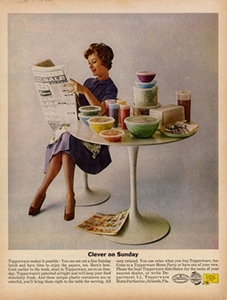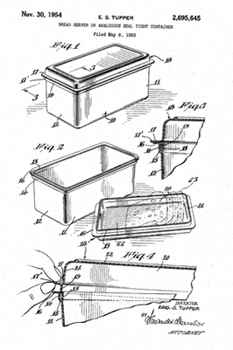 Earl S. Tupper envisioned himself a modern day Leonardo da Vinci. He was always dreaming up new inventions. He filled notebooks with his ideas which included an improved garter for stockings, permanent-press trousers, and a boat powered by fish. He even received several patents for shoe heals and a comb case. None of his ideas led to the success Tupper was hoping for until he began working with plastics.
Earl S. Tupper envisioned himself a modern day Leonardo da Vinci. He was always dreaming up new inventions. He filled notebooks with his ideas which included an improved garter for stockings, permanent-press trousers, and a boat powered by fish. He even received several patents for shoe heals and a comb case. None of his ideas led to the success Tupper was hoping for until he began working with plastics.
The Great Depression led to the bankruptcy of Tupper’s tree doctoring business. In order to make a living, he began working at a DuPont-owned plastics plant in Leominster, Massachusetts, Eventually his entrepreneur spirit led him to go back into business for himself. Tupper purchased some plastic molding machines and started Tupper plastics. At first, his new company produced cigarette cases and beads.
It was a plastic bowl that finally led to Tupper’s success. Tupper began working with polyethylene to create a plastic bowl with a sealable lid. After many design failures, Tupper came up with a great design. The “wonderbowl” had an airtight seal modeled on a paint can.
 Tupper applied for a patent on May 8, 1950. He received US Patent 2,695,645 on November 30, 1954 for a Bread Server or Analogous Seal Tight Container. This was the patent for the newly designed lid. To seal the lid lift the top a tad, “burp” out some air, and push down.
Tupper applied for a patent on May 8, 1950. He received US Patent 2,695,645 on November 30, 1954 for a Bread Server or Analogous Seal Tight Container. This was the patent for the newly designed lid. To seal the lid lift the top a tad, “burp” out some air, and push down.
Tupper tried selling his new bowls in the department stores. He had very little success. But a woman who had previously sold Stanley Home Products at home parties realized that Tupperware could also be sold using the same party marketing idea. Her parties outsold the store sales of Tupperware. Tupper soon realized that the party marketing ideas was a success. He made Brownie Wise his vice president and head of the sale division.
Tupper’s burp seal and Wise’s marketing made Tupperware into an extremely successful business. The plastic bowls perfect for leftovers have been sold in more than one hundred countries around the world.
